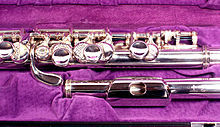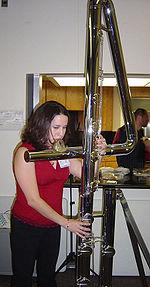- Members of the western concert flute family
-
The western concert flute family has a wide range of instruments.
Contents
Piccolo
Main article: PiccoloThe piccolo is the highest pitched member of the flute family, with a range an octave above that of the concert flute. It's usually the highest pitched instrument within orchestras and bands. The piccolo has a stereotype for being difficult to play in tune; its small size makes it difficult to construct an evenly-tuned scale.
Treble flute
Main article: Treble fluteThe treble flute is pitched in the key of G, a fifth above the concert flute. The instrument is rare today, only occasionally found in flute choirs or private collections.
Soprano flute
Main article: Soprano fluteThis distinctive sounding instrument is rarely found at present. A few American publications for flute choir currently include a part for an Eb (soprano) flute, an instrument pitched a minor third higher than the standard C flute. In these publications, an alternative part is provided either for the C Flute or for the piccolo.
Concert flute
Main article: Western concert fluteThe standard concert flute is by far the most common member of the flute family. The flute is used in many ensembles including concert bands, orchestras, flute ensembles, occasionally jazz bands and big bands.
The instrument is pitched in C and has a range of just over three octaves starting from the musical note C4 (corresponding to middle C on the piano), however, some experienced flautists are able to reach C8. Many professional flutes have a longer B-foot joint, which can reach B3.
Flûte d'amour
Main article: Flûte d'amourThe flûte d'amour or flauto d'amore is pitched in either A or B♭ and is intermediate in size between the modern C concert flute and the alto flute in G. It is the mezzo soprano member of the flute family. It is sometimes referred to as a tenor flute. The range of the instrument is from A♭3 to E7. The B♭ version is usually used for jazz because both the tenor saxophone and clarinet are in B♭.
Alto flute
Main article: Alto fluteThe alto flute is characterized by its distinct, mellow tone in the lower portion of its range. The tube of the alto flute is considerably thicker and longer than a C flute and requires more breath from the player. However, this gives it a greater dynamic presence in the bottom octave and a half of its range. It is pitched in the key of G (sounding a 4th lower than written) with its range stretching from G3 to G6. The headjoint may be straight or curved.
Bass flute
Main article: Bass fluteThe bass flute is pitched in the key of C, an one octave below the concert flute. Because of the length of its tube (approximately 146 cm), it is usually made with a curved headjoint, sometimes in a "J" shape, to bring the embouchure hole within reach of the player. It is usually only used in flute choirs, as it is easily drowned out by other instruments of comparable register, such as the clarinet.
Contra-alto flute
The contra-alto flute (also called contrabass flute in G) is in the key of G, pitched one octave below the alto flute, and a fourth below the bass flute. It is so large that the instrument's body is held vertically, with an adjustable floor peg similar to that of the bass clarinet.
Contrabass flute
Main article: Contrabass fluteThe contrabass flute (sometimes also called octobass flute) is used mostly in flute ensembles. Its range is similar to that of the regular concert flute, except that it is pitched two octaves lower; the lowest performable note is two octaves below middle C (equivalent to the lowest C on the cello). Many contrabass flutes in C are also equipped with a low B, (in the same manner as many modern standard sized flutes are). The contra-alto flute is sometimes referred to as a contrabass flute in G.
Subcontrabass flute
Main article: Subcontrabass fluteAn instrument in the key of G, pitched a fourth below the contrabass flute in C and two octaves below the alto flute in G; it is sometimes also called a double contra-alto flute.
Double contrabass flute
Main article: Double contrabass fluteThe double contrabass flute (sometimes also called octobass flute or subcontrabass flute) is pitched in the key of C, three octaves below the concert flute (two octaves below the bass flute, and one octave below the contrabass flute). Its lowest note is C1, one octave below the cello's lowest C. Despite the tendency of the larger sizes of flute to be quiet, the double contrabass flute has a surprisingly powerful tone, though it benefits from amplification in ensembles.
Hyperbass flute
Main article: Hyperbass fluteThe hyperbass flute is the largest and lowest instrument in the flute family. It is pitched in C, four octaves below the concert flute (and three octaves below the bass flute, two octaves below the contrabass flute, and one octave below the double contrabass flute). It is made of PVC and wood, its tubing is over 8 meters in length and its lowest note is the C one octave below the lowest C on the piano (16 Hz), below what is generally considered the range of human hearing. The only known example of the instrument is a prototype built for Italian flautist Roberto Fabbriciani (b. Arezzo, 1949) by Francesco Romei, a Florentine craftsman.
Western concert flutes Flute family Piccolo • Treble flute • Soprano flute • Concert flute • Flûte d'amour • Alto flute • Bass flute • Contra-alto flute • Contrabass flute • Subcontrabass flute • Double contrabass flute • Hyperbass fluteFlautists Category:Flautists • Johann Joachim Quantz • Jacques-Martin Hotteterre • Theobald Boehm • Marcel Moyse • Louis Moyse • Jean-Pierre Rampal • James Galway • Julius Baker • Paula Robison • Ransom Wilson • Herbie Mann • Hubert Laws • James Newton • Ian Anderson • Peter Gabriel • Nestor Torres • Robert Dick • Tim Barsky • Greg Pattillo • Severino Gazzelloni • Paul Taffanel • Philippe Gaubert • Robert LangevinFlute makers Ensembles and compositions Other Categories:- Flutes
Wikimedia Foundation. 2010.









